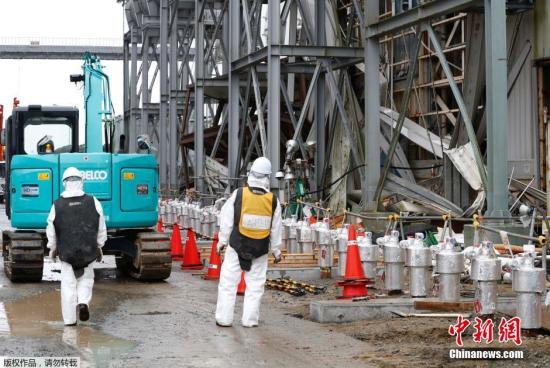China News Service, April 10th. According to a Hong Kong "Ta Kung Pao" report on the 10th, 10 years have passed since the accident at the Fukushima Daiichi nuclear power plant in Japan, but the work of cleaning up the mess is still not over.
In addition to the unresolved nuclear waste water problem, the Japanese government is also facing the cleanup of highly radioactive nuclear fuel debris. Tens of thousands of people in Fukushima Prefecture have a hard time returning home...
The analysis pointed out that all kinds of circumstances made the reactor scrap and evacuation work planned to be completed from 2041 to 2051 invisible.
Japan's "basic decision" to discharge nuclear sewage from the Fukushima Daiichi Nuclear Power Plant into the sea will not only affect the domestic ecological environment, but also cause major worries for itself and many neighboring countries.
On February 21, 2019, Japan touched the fuel debris of the Fukushima nuclear accident for the first time.
In view of the high radiation, Tepco inserted a catheter-like instrument from the penetrating part of the side of the containment, and conducted an investigation using a remote operation device.
Among the 6 deposits, 5 confirmed parts can be moved, and some can be lifted up to 5 cm, but there are still some deposits that have not been successfully operated.
Text source: Science and Technology Daily
[
Question 1: How to clean up high-radiation nuclear fuel debris?
】
On February 28, TEPCO announced that it would take out 566 spent fuel rods from the No. 3 reactor of the nuclear power plant. However, there are 1,007 spent fuel rods in the No. 1 and 2 reactors that need to be transferred to a safe location. The No. 1 to 3 reactors have a total of 880 tons. The clean-up of fuel debris is also unremarkable.
In addition, a large amount of radioactive waste will be generated in the process of scrapping the reactor, but the discussion on the subsequent treatment method and treatment site has not yet begun.
[
Question 2: 36,000 people in Fukushima County have a hard time returning home!
】
According to reports, the Fukushima prefectural government stated that there are still about 36,000 people living in and out of the prefecture, and there are still 7 municipalities left in the "difficult to return home" area with heavier pollution.
Although the Japanese government has set up specific reconstruction sites and sought to take the lead in decontamination to allow people to relocate, it has not given a specific timetable for decontamination and evacuation. People have expressed that "the future cannot be foreseen."
Data map: Tepco restarted the dismantling of the non-proliferation cover of Unit 1 of the Fukushima Nuclear Power Plant.
The picture shows the scene taken by the reporter at the Fukuno No. 1 Nuclear Power Plant of TEPCO.
[
Question 3: 15 places in the world still restrict imports of Japanese food
]
Although the Japanese government has repeatedly emphasized the safety of the discharged nuclear waste water, Tepco once said that it has filtered the nuclear waste water to remove high-level radioactive substances such as strontium and cesium, leaving tritium, which is relatively difficult to remove and less harmful to humans.
However, some media pointed out that in 2018, TEPCO admitted under external pressure that nuclear waste water contained tritium as well as other radioactive materials.
Once the nuclear waste water is discharged into the sea, it will have a major impact on the ecological environment and will deal a huge blow to the local fisheries in Japan.
According to Kyodo News, 15 countries and regions still maintain import restrictions on Japanese food due to the Fukushima nuclear accident.
In June 2020, the National Federation of Fisheries Associations of Japan unanimously adopted a resolution to "resolutely oppose" the discharge of nuclear waste water into the sea, and submitted a petition to the government.
The Japanese government originally planned to issue a decision on the discharge of nuclear waste water into the sea in October 2020, but this was temporarily shelved due to strong domestic and foreign opposition.
However, on the 9th, the Japanese Minister of Economy, Trade and Industry Hiroshi Kajiyama said: "The reputational damage will definitely happen, and we can only deal with it with all-round measures." The Japanese government is discussing a compensation plan for fisheries.
On August 8, 2014 local time, in Fukushima, Japan, people demonstrated against Tokyo Electric Power Company’s discharge of sewage into the sea.
【
Draining nuclear sewage into the sea, it is difficult for Japan to "get it off once and for all"
】
According to a report from the Japan Broadcasting Association (NHK) on April 9, the Japanese government has basically decided to discharge nuclear sewage from the Fukushima Daiichi Nuclear Power Plant into the sea.
The government will hold a relevant cabinet meeting on the 13th to formally decide whether to discharge to the sea.
The analysis pointed out that Japan's move not only affects the domestic ecological environment, but also poses a major concern for itself and many neighboring countries. Even the United States, which is as far away as the Pacific Ocean, cannot sit back and relax.
Korean media pointed out that the polluted seawater will reach Jeju Island in 220 days and the west coast of South Korea in 400 days.
The German Antarctic Ocean Agency warned that if Japan discharges all waste water into the sea, within half a year, the entire Pacific Ocean will face a high degree of radiation threat, including the United States.
By then, not only coastal residents will be directly harmed, but the marine environment and organisms will also be polluted, which will eventually cause secondary harm to the human body.

